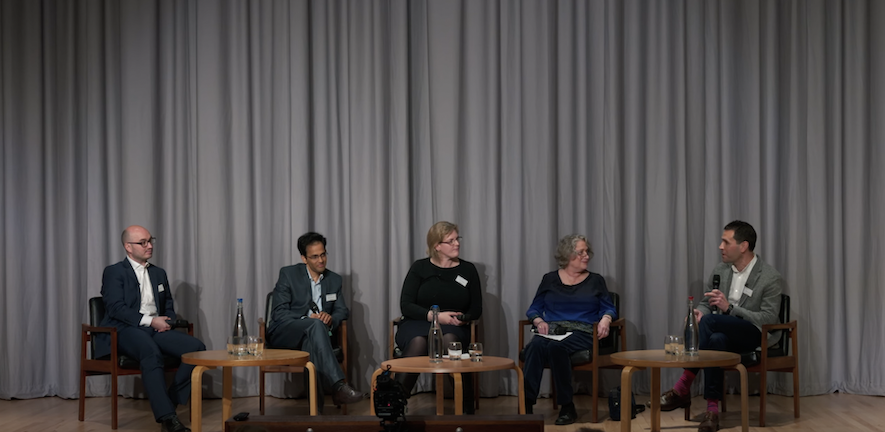
Submitted by Administrator on Mon, 13/12/2021 - 10:32
On 11 November 2021 we launched the Cambridge Initiative for Planetary Science and Life in the Universe (IPLU) at the Wolfson Hall, Churchill College, where we brought together researchers from different disciplines to discuss practical ways to investigate fundamental questions on the origin and nature of life in the Universe.
Led by 2019 Physics Nobel Laureate Professor Didier Queloz, the Cambridge IPLU will be the driving force for the development of a new research community investigating life in the Universe, from understanding how it emerged on Earth to examining the processes that could make other planets suitable for life.
Queloz gave the opening speech, explaining the latest developments in the field, focusing on three elements: the detection and characterisation of exoplanets, exploration of Mars, and progress made in chemistry and biochemistry. Queloz explained the role of the initiative, “We will be trying to enable the science and enhance networking: can we fight the jargon? Can we learn from each other by working across disciplines? Can we develop a new way of thinking about this topic?”
The IPLU is supported by the School of Physical Sciences at the University of Cambridge, with Departments participating in the initiative including the Cavendish Laboratory, Department of Earth Sciences, Yusuf Hamied Department of Chemistry, Institute of Astronomy, and Department of Applied Mathematics and Theoretical Physics.
The panel included:
- Alex Archibald, Professor of Atmospheric Chemistry and Climate Science at the Yusuf Hamied Department of Chemistry.
- Nikku Madhusudhan, Professor of Astrophysics and Exoplanetary Science at the Institute of Astronomy.
- Dr Emily Mitchell, NERC Independent Research Fellow at the Department of Zoology.
- Nicholas Tosca, Professor of Mineralogy and Petrology at the Department of Earth Sciences.
The discussion was moderated by Liba Taub, Professor of History and Philosophy of Science at the University of Cambridge, and Director and Curator of the Whipple Museum of the History of Science. Dr Mejd Alsari, who manages the initiative, also gave an overview of the opportunities offered by the initiative, including the funding allocated to support interdisciplinary research on the topic.
The panellists shared their thoughts on why now is the perfect time to launch such an initiative, “There have been simultaneous revolutions in exoplanet discoveries, prebiotic chemistry and solar system exploration: all reaching a crescendo over the last few years. They are all revolutions within their own disciplines, but they have had profound impacts across the field of planetary sciences. Now is definitely the right time to come together.” said Tosca.
Tosca, who is a member of the Science Team for the Mars 2020 Mission, explained that within 10 years we will have the opportunity to know whether traces of ancient microbial life are present in the rocks collected from Mars.
“Cambridge is unique in the sense that we have very strong expertise across all these areas within one institution, which is really remarkable. In my own area, we will see key steps in this decade: there will be three space missions looking at atmospheres of planets. It's the perfect moment for the IPLU — we have to seize the opportunity to make those big advances,” said Madhusudhan.
Archibald commented on the challenges involved with such an initiative, “We live in this world of big data. But the conversion of data to information is really tough — the way forward is to access the collective knowledge of those disciplines together. But that's what initiatives are for.”
Moving on to developments in biosignatures, which can be used to trace signs of life, Mitchell said, “I find it a fascinating thing to think about the biosignatures we might find. There's a huge potential for life to exist on other planets in vast quantities, but just to be relatively simple, and not the kind of exciting animals that we are familiar with.”
“More recently, there have been suggestions of focusing on secondary biomarkers. Several of these are produced in small quantities and are exclusively traceable to life on Earth. For example, chemicals like methyl chloride or dimethyl sulphide are thought to be produced mostly by life here on Earth,” said Madhusudhan.
The discussion concluded with comments from the panellists about their vision for the future of the initiative. “My vision is to integrate what we've been doing with Earth and Earth-system models beyond our planet. Working towards numerical simulators that allow us to throw away the constraints of the old ways of thinking.” said Archibald.
Madhusudhan added: “My grand vision is that by the end of this decade, we might be able to come up with this holistic perspective, bringing together subject expertise so we are able to explain a biosignature that we could be seeing.” Mitchell agreed, saying that “If, in 20 years’ time, we have access to multiple biosignatures, then we can use them to constrain our understanding of evolution.”
Mitchell explained: “But in the short term, it's about using ecological and evolutionary patterns to work out the limits of detecting biosignatures on other planets — is there a scenario where we could have life going on that we're not able to detect yet?”
Looking to future generations of scientists, Tosca said, “I hope that we can cultivate a new generation of scholars who can ask good questions, who can use their training in physics, chemistry, mathematics and earth sciences, to really do science in a way that they maybe couldn't do elsewhere.”
Queloz gave the closing remarks, emphasising the role that arts and humanities play in such an initiative, “We believe that combining the arts and sciences should be part of this way of thinking, and this is one of the main developments we're trying to grow right now.”
